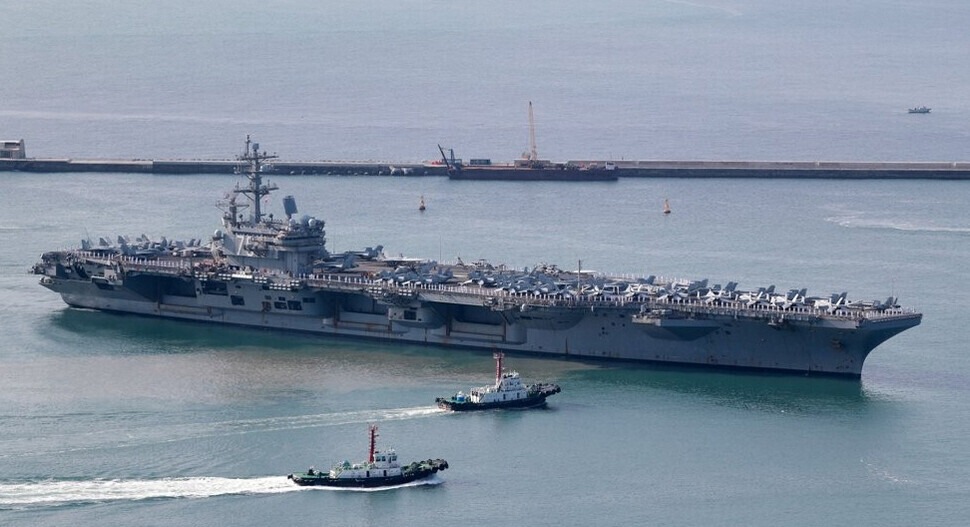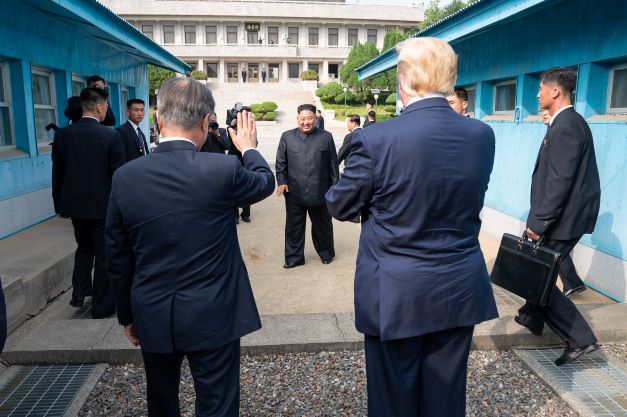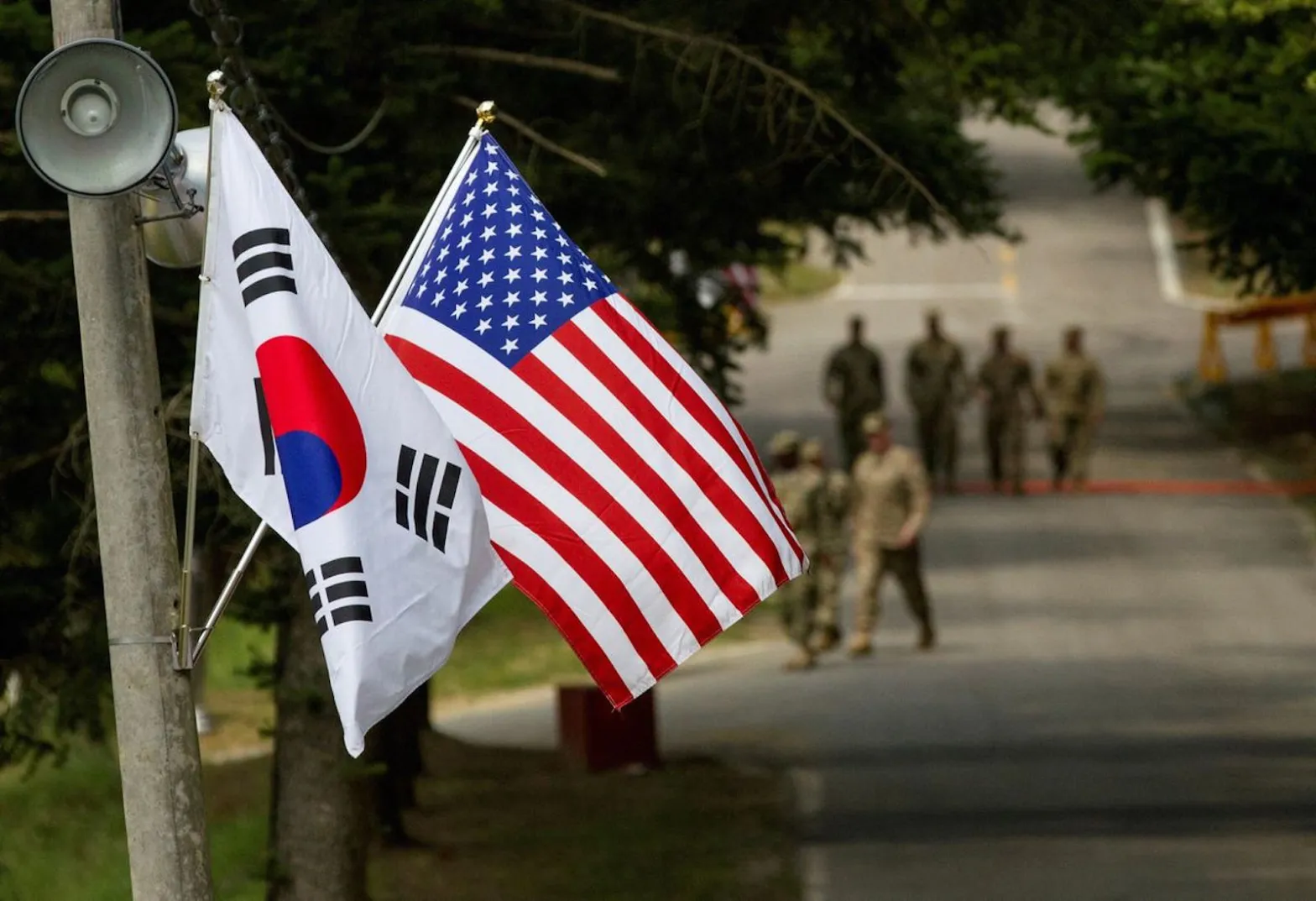Two Koreas’ Contest of Strength Reaches Fever Pitch
HANKYOREH
APLN member Cheong Wook-Sik argues that while the two Koreas are quickly becoming engulfed in a contest of strength, a different approach is needed. What is urgently required now is the suspension of North Korean nuclear tests and ballistic missile launches, as well as South Korea’s joint exercises with the US and Japan. Read the original article here.
While “Fight Tonight” is the traditional slogan of the South Korea-US alliance, North Korea has recently demonstrated that it is constantly prepared to wage combat.
The two Koreas are quickly becoming engulfed in a contest of strength, with both sides engaged in tit-for-tat shows of force since the end of September.
It began with the arrival of the USS Ronald Reagan carrier strike group to the port city of Busan on Sept. 23. North Korea, which refused to sit idly by as this unfolded, launched a ballistic missile designed to simulate one loaded with a tactical nuclear warhead at an underwater launch site in a reservoir in the country’s northwest early on Sept. 25. This missile launch was North Korea’s first ever conducted in a reservoir rather than at sea and can be understood as an attempt to avoid South Korea’s “kill chain,” a system designed to carry out a preemptive strike against the North in the face of an imminent threat.
South Korea and the US conducted scheduled joint naval exercises with the USS Ronald Reagan in the East Sea from Sept. 26 to 29. It was the first time in five years that an American nuclear aircraft carrier participated in a joint naval exercise. North Korea also conducted the bulk of its recent missile tests during this time period.
On the afternoon of Sept. 28, the North conducted a ballistic missile test designed to simulate a tactical nuclear strike “with the aim of neutralizing airfields within the combat zone in South Korea.” This was followed by the launch of two short-range missiles into the East Sea the next day.
Tit-for-tat confrontation intensifies
On Sept. 30, South Korea, the US and Japan began trilateral anti-submarine exercises that simulated the launch of a submarine-launched ballistic missile (SLBM) by North Korea. It was the first time that such trilateral anti-submarine drills were conducted in the East Sea.
Following this, North Korea once again launched two short-range missiles into the East Sea on Oct. 1. The North announced that it had conducted “various types of tactical ballistic missile launch exercises” on Sept. 29 and Oct. 1, including the hitting of targets with air explosions and direct precision and dispersion strikes. The purpose of these exercises, which combine various types of missiles and demonstrate the North’s ability to launch multiple missiles nearly simultaneously, can be understood as an attempt to show that it can block the access of a US carrier battle group to the East Sea.
That is not all: North Korea also test fired a new-type surface-to-surface intermediate-range ballistic missile (IRBM) on the morning of Oct. 4. North Korea announced that this launch was carried out following “a resolution to send a forceful and clear warning to our enemies in response to the ongoing unstable situation” by the ruling Workers’ Party’s Central Military Commission and that the missile was designed to “to cross the Japanese archipelago and strike a set target in the waters of the Pacific Ocean 4,500 km away.”
It has been interpreted that this launch was carried out with Guam, a strategic base for the US military, in mind.
Following this, South Korea and the United States immediately conducted Joint Direct Attack Munition (JDAM) precision bombing drills involving F-15K and F-16 fighter jets. The two nations also conducted joint surface-to-surface missile tests with ATACMS and Hyunmoo-2C missiles on the night of the Oct. 4 into the early morning of the next day.
These two tests were intended to display the ability of the Korean and American militaries to quickly and precisely take out North Korean missile bases in an emergency situation. However, the Hyunmoo-2C missile crashed into a South Korean airbase in Gangneung following an “abnormal flight” shortly after it was launched.
On Oct. 5, a US carrier strike group, which had previously returned to port after completing training exercises, re-entered the East Sea. This move was aimed at reaffirming the US’ security commitments to South Korea and Japan, which were shocked by North Korea’s IRBM test, as well as to display its willingness to respond strongly to North Korean provocations.
North Korea, however, did not back down.
In the early morning of Oct. 6, North Korea conducted target exercises with a super-large multiple rocket launcher (MRL) and a tactical ballistic missile, in addition to conducting a joint fire attack training exercise with its long-range artillery division and air force squadron along the western front-line border with South Korea. North Korea stated that the purpose of these drills was to “demonstrate the accuracy of our operational readiness and our high-level practical capabilities in case of emergency.”
While South Korea, the US and Japan were conducting trilateral exercises in international waters in the East Sea, North Korea staged an unprecedented show of force. For the first time in history, North Korea conducted a “comprehensive air attack drill” involving some 150 warplanes in order to demonstrate its ability to mobilize large numbers of aircraft as well as nuclear weapons, missiles, and long-range artillery in case of emergency, despite a severe shortage of fuel.
The saber-rattling on both sides did not end here. The US announced on Oct. 7 that the 2nd Stryker Brigade Combat Team (SBCT) would arrive at the port in Pyeongtaek-Dangjin the following day. This was the first time the combat team was deployed to South Korea.
North Korea then subsequently conducted a “super-large” MRL drill early on Oct. 9 to “simulate a strike on major enemy ports,” according to North Korean state media. Some interpret this drill to be a response to the deployment of the SBCT, an analysis that is supported by the fact that the range of the North Korean MRL is around 350 km, or 217 miles.
North Korea also test-fired a long-range strategic cruise missile with a range of 2,000 km on Wednesday, followed by a short-range ballistic missile test and the firing of some 170 artillery rounds on Friday. These tests were conducted as North Korea condemned the South Korean military for carrying out artillery exercises for “a full 10 hours near the forward defense area.” Earlier on Thursday night, after about ten North Korean military aircraft flew close to the border to intimidate the South, the South Korean air force responded with the launch of F-35A fighter jets.
Although it is unclear how long this confrontation will last, one thing is certain: North Korea has undergone a fundamental shift.
In the past, although ROK-US or ROK-US-Japan joint exercises sparked backlash from the North, it refrained from responding with military action while the drills were being carried out. But this time was different. North Korea immediately responded to each particular bilateral and trilateral military exercise in a different manner.
Confrontation marked by mutual hate and mutual resemblance
This section will show how military confrontation between South Korea, the US, and Japan on one side and North Korea on the other is causing all sides to become more and more similar to each other.
While “Fight Tonight” is the traditional slogan of the South Korea-US alliance, this time North Korea also demonstrated that it is constantly prepared to wage combat. In addition, the Yoon Suk-yeol administration has put great emphasis on South Korea’s “alliance in action” with the US as well as on trilateral security cooperation with the US and Japan with the goal of demonstrating not merely through words but also through action the iron-clad will of the three countries to respond strongly to provocations by the North.
North Korea has changed as well. It not only has offered diplomatic criticism of the South Korea-US and South Korea-US-Japan joint drills and military buildup, but it has also demonstrated through action that it can respond in kind. This shift can be attributed to North Korea’s newfound confidence stemming from its belief that it achieved a balance of power by strengthening its nuclear arsenal.
As such, mutual hostility and shows of force are increasing day by day, but both sides hope for the same thing: avoiding war.
However, recently, both sides have come to completely rely on deterrence, threatening to blow the other to smithereens in the case of an armed attack. If words and actions aimed at preventing war are in actuality leading us to a situation in which we need to worry about the possibility of war, a different approach is needed. What is urgently required now is the suspension of North Korean nuclear tests and ballistic missile launches, as well as South Korea’s joint exercises with the US and Japan.
American presidents have been promising the suspension of joint military exercises as early as 30 years ago and as recently as three to four years ago. If the non-fulfillment of such promises is a major cause of the crisis we are facing today, South Korea and the US need to show good faith and clean up the mess they have made. Only then can we effectively deal with the new North Korea.


![[NU-NEA] US Entry into the Korean War: Origins, Impact, and Lessons](https://cms.apln.network/wp-content/uploads/2021/12/KakaoTalk_Photo_2021-12-16-11-57-19.jpeg)

